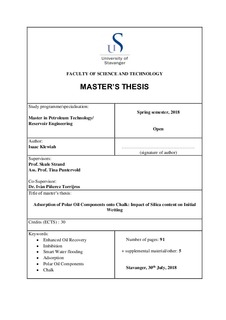| dc.contributor.advisor | Strand, Skule | |
| dc.contributor.advisor | Puntervold, Tina | |
| dc.contributor.author | Klewiah, Isaac | |
| dc.date.accessioned | 2018-10-29T09:27:26Z | |
| dc.date.available | 2018-10-29T09:27:26Z | |
| dc.date.issued | 2018-07-30 | |
| dc.identifier.uri | http://hdl.handle.net/11250/2569890 | |
| dc.description | Master's thesis Petroleum engineering | nb_NO |
| dc.description.abstract | The wetting state of reservoir rocks, particularly naturally fractured chalk, is fundamental in the efficient application of advanced oil recovery methods by injection of water. In the subsurface crude oil/brine/rock system, a chemical equilibrium between the phases has established a characteristic initial wetting of the system. Experimental studies have revealed the adsorption of polar organic components from crude oil onto the rock surface as the main influence on initial wetting. In the Laboratory, outcrop chalks, are often used as analog materials for chalk reservoir studies. Stevns Klint (SK) chalk, which is a relatively pure outcrop, has been vigorously studied regarding initial wetting but little attention has been given to the adsorption efficiency of polar components onto outcrop chalk of considerable silica impurity.
In this study, experiments have been performed on Aalborg (AA) chalk material, with significant amount of silica (SiO2) impurity (6-8 At% Si) and possible silicate materials present as clay flakes to quantify the retention of polar acidic and basic components of crude oil onto the chalk surface. In previous experiments, the adsorption has been examined on SK chalk samples (with < 2 At% Si) under the same experimental conditions so the results from this study are analyzed in comparison to the previous knowledge.
Approximately 7PV of Crude oil with known acid number (AN) and base number (BN) was flooded through a core sample (AA#1) at 50°C to measure the changes in AN and BN at the core outlet. The amount of crude oil polar organic components adsorbed was quantified in relation to the area above the curve plot of effluent AN/BN versus PV flooded. Another core (AA#2) was flooded with 5PV of the same crude oil to investigate the impact that crude oil injected volume has on Aalborg chalk wetting. Both oil-saturated samples were aged for 2 weeks at 50°C in the same crude oil and their wetting states evaluated by spontaneous imbibition (SI), forced imbibition (FI) and chromatographic wettability tests (CWT). The studies confirmed that; 1) The adsorption of polar crude oil components is an instantaneous process that occurs as soon as the oil contacts the porous media. 2) Adsorption of acidic components onto Aalborg chalk surface was less profound as compared to SK chalk. 3) The adsorption of basic components was significantly higher compared to SK chalk. 4) Water wetness increased with decreasing the number of pore volumes of crude oil injected.
The high silica content of Aalborg seems to inhibit adsorption of negatively charged acidic components but promotes higher adsorption of basic components and reveals the impact that chalk silica content will have on the initial wetting potential of the different polar components in crude oil. This is a fundamentally essential information for the developments of theoretical and chemical models to explain wettability alteration in chalk reservoirs and highlights the essence of exercising cautions discretion when choosing any outcrop chalk material for parametric laboratory studies to characterize natural reservoir chalk rock behavior. | nb_NO |
| dc.language.iso | eng | nb_NO |
| dc.publisher | University of Stavanger, Norway | nb_NO |
| dc.relation.ispartofseries | Masteroppgave/UIS-TN-IEP/2018; | |
| dc.subject | adsorption | nb_NO |
| dc.subject | polar oil components | nb_NO |
| dc.subject | Aalborg Chalk | nb_NO |
| dc.subject | enhanced oil recovery | nb_NO |
| dc.subject | reservoarteknologi | nb_NO |
| dc.subject | imbibition | nb_NO |
| dc.subject | smart water flooding | nb_NO |
| dc.subject | petroleumsteknologi | nb_NO |
| dc.subject | petroleum technology | nb_NO |
| dc.title | Adsorption of Polar Oil Components onto Chalk: Impact of Silica content on Initial Wetting | nb_NO |
| dc.type | Master thesis | nb_NO |
| dc.subject.nsi | VDP::Teknologi: 500::Berg‑ og petroleumsfag: 510::Petroleumsteknologi: 512 | nb_NO |
